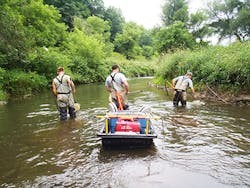Monitoring finds no harm to Marcellus water
The Susquehanna River Basin Commission (SRBC) said Marcellus shale development has not harmed water quality based on findings from its third report on water-quality conditions in select watersheds within SRBC.
SRBC in 2010 began collecting the data through its Remote Water Quality Monitoring Network (RWQMN). Very little information existed on water quality for many smaller streams in northern Pennsylvania and the southern tier of New York before RWQMN, said SRBC of Harrisburg, Pa.
A water-resource governing agency, SRBC was established under a 100-year compact signed on Dec. 24, 1970, by the federal government and the states of New York, Pennsylvania and Maryland. The Susquehanna River starts in Cooperstown, NY, and flows 444 miles to Havre de Grace, Md., where the river enters Chesapeake Bay.
The first report in 2012 established existing conditions within 37 of 59 watersheds, which are monitored through the RWQMN. The group's third report provided a more comprehensive report of conditions across the full monitoring network.
"The commission takes very seriously one of its core functions of monitoring water-quality conditions in the streams and rivers of the Susquehanna Basin," said SRBC Executive Director Andrew Dehoff. SRBC evaluates whether conditions in streams are showing any changes associated with natural gas drilling.
SRBC's objective for the RWQMN is to apply best-available science to track changes in water quality experienced over time and to allow for timely responses in the case of pollution. Other objectives are to reduce the cost of data collection, to enhance water protection through monitoring, and to be responsive to public concerns.
Each RWQMN station is equipped with sensors that can continuously detect changes. The water quality parameters are measured at 5-min intervals and transmitted to SRBC headquarters in Harrisburg every 2-4 hr.
Of the 58 watersheds covered in this report, SRBC reported:
• No indications of any changes in water quality with continuous monitoring from 2010-13.
• With a few exceptions, water chemistry at the monitoring stations indicated good water quality, and the results of aquatic-insect monitoring were not affected by the density of upstream gas wells or pads.
As more stations accumulate additional years of continuous data, SRBC staff expects to detect any longer-term water quality trends in addition to immediate impacts.
About the Author
Paula Dittrick
Senior Staff Writer
Paula Dittrick has covered oil and gas from Houston for more than 20 years. Starting in May 2007, she developed a health, safety, and environment beat for Oil & Gas Journal. Dittrick is familiar with the industry’s financial aspects. She also monitors issues associated with carbon sequestration and renewable energy.
Dittrick joined OGJ in February 2001. Previously, she worked for Dow Jones and United Press International. She began writing about oil and gas as UPI’s West Texas bureau chief during the 1980s. She earned a Bachelor’s of Science degree in journalism from the University of Nebraska in 1974.


